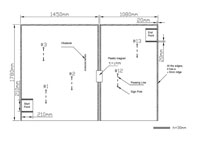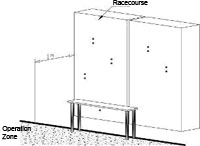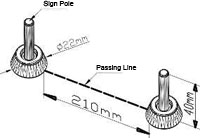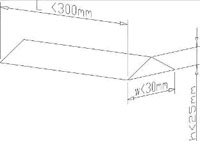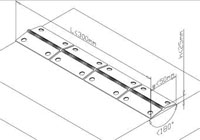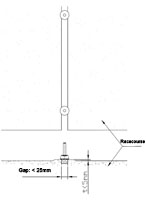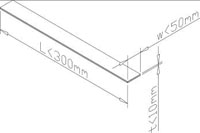2012 Communications Museum Electronic Device Construction Competition
REGULATIONS - SENIOR SECONDARY GROUP
Operational Function of Device:
Device can be controlled to move, surpass obstacles and pass through checkpoints on an iron vertical surface.
Materials: Production materials are not limited, but ready-made devices are not allowed.
Specifications:
-
Dimensions and weight restrictions:
- The construction should be composed of three parts: device, wire for control and controller.
- The device should be within the size of 21cm (length) x 21cm (width).
- Restrictions on wire for control: The wire that connects the device and the controller should be at least 4m long.
- Restrictions on source of power: The device should be driven by battery. The quantity used is limited to a maximum of 8 AA batteries at one time.
Sequence of Competition: The sequence of competition for each team will be determined by drawing.
Format of Competition: For the Senior Secondary Group, the teams are allowed to control their devices to pass through the racecourse only once, within the time limit.
Competition Ground: The competition ground includes an operation zone, starting/end point, racecourse (obstacles and checkpoints). See [Figure 1] for specifications of the competition ground. The complete settings of the Competition Ground will be announced only on the day of the competition.
Flow of Competition:
- Before the competition, the operator and other team members should stand by at the [operation zone], see [Figure 2].
- Each team should assign one operator to use the controller to operate all movements of the device, but he/she is not allowed to touch the device during the operation. The other team members are responsible for the repair work of the device, and they are not allowed to operate it. If the team only has one member, he/she will be in charge of both the operation and repair work of the device.
- Before the competition, each team can use 1 minute to adjust their device. The device adjustment cannot be done in the [racecourse].
- After the preparation time is over, the team should stop all adjustments of the device, and follow the staff's instruction to locate the device at the [starting Point].
- The wire for control should be fixed to the [fixing point of wire for control] by the staff. During the competition, the operator and other team members must stay inside the [operation zone].
- After the staff has signified the commencement of the competition, he/she will start to count the time. During the competition, all the team members must not do any actions that may facilitate the operation of the device (e.g. pulling the wire for control).O therwise, it will be considered as violation of rules.
- When the device arrives at the [end point], the competition time is over. The maximum [Time Used in Competition] for each team is 5 minutes. When the time is up, all movements must stop. When the competition of each team is finished, the staff will record the completing time, number of checkpoints passed through and calculate the total scores.
Method of Using the Racecourse:
There are 13 checkpoints, each labeled from 1 to 13 on the racecourse. Each checkpoint is composed of 2 [sign poles] and 1 [passing line], see [Figure 3]. Scores will be counted only if the whole device has completely passed through the [passing line] of a particular checkpoint. While moving on the racecourse, the device must pass through the checkpoints in an ascending order in terms of their numbers labeled. Nonetheless the teams can choose to bypass any of the checkpoints. If the device passes through a particular checkpoint with a number smaller than that of the previous checkpoint it has passed through, the score of that particular checkpoint will not be counted. Please refer to the following examples:
| Sequence of checkpoints passed through | Checkpoints that are valid for score calculation |
|---|---|
| 1 -> 2 -> 3 -> 5 | 1,2,3,5 (Total: 4 checkpoints) |
| 1 -> 5 -> 4 -> 3 -> 4 | 1,5 (Total: 2 checkpoints) |
| 1 -> 5 -> 3 -> 4 -> 6 | 1,5,6 (Total: 3 checkpoints) |
| 1 -> 5 -> 5 -> 3 -> 4 | 1,5 (Total: 2 checkpoints) |
For checkpoint score calculation, please refer to the formula listed below.
Calculation of Scores:
The score calculation is composed of two parts, namely [Checkpoint Score] and [Time Factor]. The calculation of these two parts will produce the final scores. The calculation method of each part is explained in the following.
-
[Checkpoint Score] : Calculate the scores earned by passing through checkpoints
Number of Checkpoints Passed through Scoring Method Checkpoint Scores Example 1 10 10 Assuming the sequence of passing through the checkpoints is 1 -> 2 -> 3 -> 5, the number of checkpoints counted is 4 (numbered 1, 2, 3 and 5 are valid). Thus, Checkpoint Score is (4(4+1)/2)*10 = 100
Assuming the sequence of passing through the checkpoints is 1 -> 5 -> 4 -> 3 -> 4, the number of checkpoints counted is 2 (numbered 1 and 5 are valid). Thus, Checkpoint Score is (2(2+1)/2)*10 = 302 10+20 30 3 10+20+30 60 4 10+20+30+40 100 N 10+20+30+...+10N (N(N+1)/2)*10 -
[Time Factor] : The Time Factor of each team will be calculated according to their corresponding time used in competition, as shown in the following table:
Time Used in Competition Time Factor [Final Competition Time] is defined as: [Time Used in Competition] + [Additional Time from Penalty]
[Additional Time from Penalty] resulted from violation of rules: If the device touches a [sign pole] in any way during the competition, 20 seconds will be added as penalty. However if the same [sign pole] is touched repeatedly, additional time will be counted once only.
Example: when [Time Used in Competition] is 1 min 39 sec and the rule is violated once, the [Final Competition Time] = 1 min 39 sec + 20 sec = 1 min 59 sec, it means the [Time Factor] = 2.5.Less than 1 minute 3 Less than 2 minute 2.5 Less than 3 minute 2 Less than 4 minute 1.6 Less than 5 minute 1.3 5 minutes 1.1 Over 5 minutes 1 - [Total Score] : The calculating formula is [Checkpoint Score] x [Time Factor] = [Total Score]. After the score calculation for all teams, the one that has the highest [Total Score] will win. If more than one team has the same highest [Total Score] , the team that has passed through more checkpoints will win. If the number of checkpoints that they have passed through is also the same, then the team that has a heavier device will win.
Obstacles:
Several obstacles will be located in the Competition Ground. The teams can use different ways that abide by the rules and regulations of this competition to get over the obstacles. Alternatively they may choose to bypass them and continue with the competition. The obstacles can be one of the following categories:
- Slopes: Formed by a connecting an upward and a downward inclined surface. It is made of iron or wood, see [Figure 4] and [Figure 5] .
- Gaps: Located in between two iron cabinets, see [Figure 6] and [Figure 7] .
- Blocks: Made of wood, see [Figure 8] and [Figure 9] for the format.
Note: The figures of the obstacles listed above are for reference only. The arrangement of the obstacles in the actual competition may not necessarily be the same of those shown in the figures.
Completion of Competition: The competition can be completed in one of the following ways
- Completion within the time limit: Checkpoint scores will be counted only if the whole device arrives at and completely passes through the [end point] within 5 minutes. The time at the moment when the device passes through the [end point] will be recorded as the [Time Used in Competition] .
- Incompletion within the time limit: If the device fails to arrive and completely pass through the [End Point] when 5 minutes are up, only the valid checkpoint scores within the time limit will be counted. The [Time Used in Competition] will be recorded as 5 minutes.
- Termination of competition before time limit: If all team members agree, the competition can be terminated before the 5-minute time limit, only the valid checkpoint scores within the time limit will be counted. The [Time Used in Competition] will be recorded as 5 minutes.
Maintenance:
The contestants can perform maintenance work on the device, wire for control and controller (including changing of parts and batteries) during the competition. While the repair work is in progress, the competition time will continue to be counted. The scores obtained and the checkpoints passed through prior to the maintenance will not be counted. If any repair work is required during the competition, the contestants should notify the staff concerned before they can enter the competition ground to get their device and perform the maintenance. After the maintenance work is finished, the contestants have to reset their device at the [starting point] to restart the competition.
Reset:
If the device fails to continue operating due to any accidental situation, the contestants may reset the device after notifying the concerned staff. The device must be reset to the [starting point] of the racecourse. The competition time will continue to be counted. The scores obtained prior to the reset action will not be counted. The following are some examples of situations in which the device may be reset:
- The device is deviated from the racecourse;
- The wire for control winds around or hinders the racecourse, affecting the running of the competition;
- Any maintenance of the device, wire for control and controller;
- The device becomes out of control;
- As requested by the contestants.
Violation of Rules:
The penalty for violation of rules in the following situations will depend on their seriousness. The team can be disqualified for the competition from serious situation.
- The device causes damage to the racecourse in any way during the competition;
- The contestants touches the device during the competition without notifying the staff;
- During the competition, any team member that is not the specified controller touches the device;
- The dimensions of the device do not follow the specifications listed in the rules and regulations;
- The contestants uses devices that have not been inspected by the Organizer of the competition;
- Without permission from the staff, the contestants enter the restricted area of competition ground during the competition;
- The contestants do not follow the instruction of the staff during the competition;
- After the commencement of the competition, team member(s) do(es) any actions that may facilitate the operation of the device (e.g. pulling the wire for control).
Others:
- All participants should pay attention to electrical safety.
- Please bring your own tools. No tools will be provided by the Organizer.
- All participants are welcome to use the testing ground in the Museum during opening hours before the competition.
About CMM
Contact US
Others
Other Websites
Number of Visitors:
Last Modified Date: 10/03/2025
